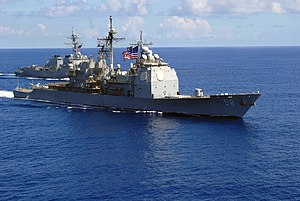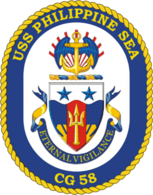USS Philippine Sea (CG-58)
 USS Philippine Sea enroute to deployment with the 6th Fleet
| |
| History | |
|---|---|
| Name | USS Philippine Sea |
| Namesake | Battle of the Philippine Sea |
| Operator | |
| Ordered | December 27, 1983 |
| Builder | Bath Iron Works |
| Laid down | April 8, 1986 |
| Launched | July 12, 1987 |
| Commissioned | March 18, 1989 |
| Homeport | Mayport, Florida |
| Motto | Eternal Vigilance |
| Status | in active service |
| Badge |  |
| General characteristics | |
| Class and type | Ticonderoga-class cruiser |
| Displacement | Approx. 9,600 long tons (9,800 t) full load |
| Length | 567 feet (173 m) |
| Beam | 55 feet (16.8 meters) |
| Draft | 34 feet (10.2 meters) |
| Propulsion |
|
| Speed | 32.5 knots (60 km/h; 37.4 mph) |
| Complement | 30 officers and 300 enlisted |
| Sensors and processing systems |
|
| Armament |
|
| Aircraft carried | 2 × MH-60R Seahawk LAMPS Mk III helicopters. |
USS Philippine Sea (CG-58) is a Flight II Ticonderoga-class guided missile cruiser on active service in the United States Navy. She is named for the Battle of the Philippine Sea during World War II and is the second ship to bear the name. The Philippine Sea was the first U.S. or allied vessel to launch missiles against Saddam Hussein's forces during the Gulf War in 1991. She has completed multiple deployments as part of Operation Enduring Freedom since 2001.
Operational history
In 2003, the ship was assigned to Cruiser-Destroyer Group 12.[1]
In 2010, the ship failed her initial Board of Inspection and Survey (INSURV) inspection.[2] On May 7, 2011, Philippine Sea departed Mayport for a scheduled overseas deployment to the U.S. Fifth Fleet and U.S. Sixth Fleet Area of Responsibility.[3] On June 3, 2011, Philippine Sea paid a port visit to Kiel, Germany, prior to participating with the multi-national exercise Baltic Operations 2011 (BALTOPS-2011). This exercise included naval units from the United States, Russian, Danish, Polish and French navies, and BALTOPS-2011 ended on June 21, 2011.[3][4][5] On July 6, 2011, Philippine Sea rescued 26 Filipino crew members from the Marshall Islands-owned, Liberian-flagged supertanker Brilliante Virtuoso southwest of Aden, Yemen, after the ship's superstructure was set on fire following a reported attack by pirates using rocket-propelled grenades (RPG).[3][6][7] Philippine Sea transited the Suez Canal on July 1, 2011.[3]
The cremated remains of Neil Armstrong were buried at sea from the warship on September 14, 2012, in the Atlantic Ocean.[8]
See also
![]() This article includes information collected from the Naval Vessel Register, which, as a U.S. government publication, is in the public domain.
This article includes information collected from the Naval Vessel Register, which, as a U.S. government publication, is in the public domain.
References
- ^ http://www.hazegray.org/worldnav/usa/surface.htm, accessed May 2012
- ^ McMichael, William "Fla. cruiser, Va. frigate flunk INSURV", Navy Times, 20 December 2010.
- ^ a b c d "USS Philippine Sea (CG-58)". U.S. Carriers: United States Ships (USS) history and deployments. December 9, 2010. Retrieved 2011-09-13.
- ^ "Second Phase of BALTOPS 2011 Takes Place in Baltic Sea". NavyToday.com. June, 2011. Retrieved 2011-09-13.
{{cite web}}: Check date values in:|date=(help) - ^ "Russia: Sea Phase of BALTOPS-2011 Finishes in Baltic Sea". NavyToday.com. June 21, 2011. Retrieved 2011-09-13.
- ^ "USS Philippine Sea Rescues Brilliante Virtuoso Crew off Aden". NNS110706-03. Combined Maritime Forces Public Affairs. July 6, 2011. Retrieved 2011-09-13.
- ^ "CMF Ship USS Philippine Sea (CG 58) rescues crew from Brilliante Virtuoso". Release #073-11. Combined Maritime Forces Public Affairs. July 6, 2011. Retrieved 2011-09-13.
- ^ "Neil Armstrong Laid to Rest in Atlantic". NASA. September 13, 2012. Retrieved 2012-09-14.
